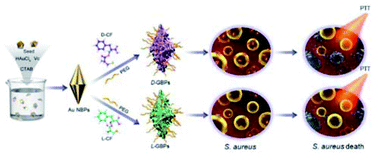Peptide-directed synthesis of chiral nano-bipyramids for controllable antibacterial application†
Abstract
The emergence of antibiotic resistance makes the therapeutic effect of traditional antibiotics far from satisfactory. Here, chiral gold nano-bipyramids (GBPs) with sea cucumber-like morphology are reported, and used in the fight against bacterial infection. Specifically, the dipeptide of D-/L-Cys-Phe (CF) caused the nano-bipyramids to form a spike shape with an optical anisotropy factor of 0.102 at 573 nm. The antibacterial effects showed that D-GBPs and L-GBPs could efficiently destroy bacteria with a death ratio of 98% and 70% in vitro. Also, both in vivo skin infection and sepsis models showed that the chiral GBPs could effectively promote wound healing and prevent sepsis in mice. Mechanistic studies showed that the binding affinity of D-GBPs (1.071 ± 0.023 × 108 M−1) was 12.39-fold higher than L-GBPs (8.664 ± 0.251 × 106 M−1) to protein A of Staphylococcus aureus, which caused further adsorption of D-GBPs onto the bacterial surface. Moreover, the physical destruction of the bacterial cell wall caused by the spike chiral GBPs, resulted in a stronger antibacterial effect for D-GBPs than L-GBPs. Furthermore, the excellent PTT of D-/L-GBPs further exacerbated the death of bacteria without any side-effect. Overall, chiral nano-bipyramids have opened a new avenue for improved antibacterial efficacy in the treatment of bacterial infections.

- This article is part of the themed collection: 2022 Chemical Science HOT Article Collection


 Please wait while we load your content...
Please wait while we load your content...